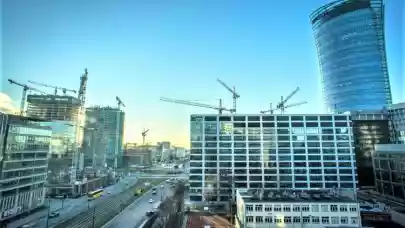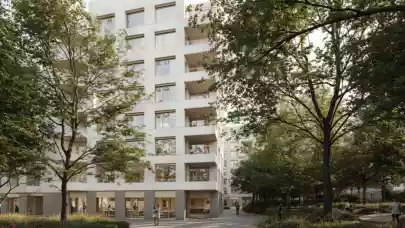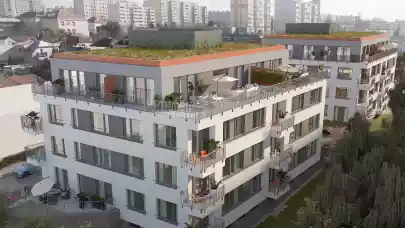
It's been a good, strong start to 2022 in Poland's office market, which offers hope that a long-awaited boom in demand is coming after a market slump. Companies have adapted to the new working conditions, and due to the easing of restrictions related to the covid-19 pandemic, they have launched a campaign to encourage employees back into offices. On the other hand, Warsaw and the eight largest regional markets, i.e., Kraków, Wrocław, Tricity, Katowice, Łódź, Poznań, Szczecin, and Lublin, may face a slowdown in new supply in the coming months. AXI IMMO looks at the current trends after Q1 2022 in the office market and analyses what will influence its development in the following months of the year.
At the end of March 2022, office developers in Poland delivered 22 projects with a total area of 336,900 sqm, which increased the total market resources to over 12.5m sqm. Most projects - 16 - were delivered in regional cities, among which noteworthy were .KTW II (39,900 sqm, TDJ Estate) and Global Office Park A1 and A2 (27,300 sqm and 29,900 sqm, Cavatina) in Katowice and the office building Midpoint71 (36,200 sqm, Echo Investment) in Wrocław. In Warsaw, at the same time, occupancy permits were granted to the Forest Tower (51,500 sqm, HB Reavis) and another stage of the LIXA complex, building C (19,400 sqm, Yareal). In terms of total office stock, Warsaw (approx. 6.23m sqm) is traditionally ahead of the eight regional office markets, of which Kraków remains the leader (1.63m sqm), followed by Wrocław (1.28m sqm) and Tricity (992,200 sqm). In terms of new supply at the end of Q1 2022, the top three were Katowice (approx. 116,300 sqm), ahead of Warsaw (93,400 sqm), and Wrocław (36,200 sqm). At the same time, the vacancy rate in the Polish office market indicated about 13.8% of the total stock, which sets availability at the level of about 1.73m sqm. In Warsaw alone, it amounts to approx. 759,700 sqm (12.2%; -0.5 pp. q/q), while in the regions 970,100 sqm (15.5%; +1.4 pp. q/q). Tenants interested in new offices outside the capital should consider cities such as Kraków (approx. 255,000 sqm), Wrocław (approx. 200,000 sqm), or Tricity (approx. 140,000 sqm), where there was relatively most available space off the shelf.
"The office market in Poland has had to apply the handbrake hard in the last two years. As a result, in the perspective of the coming months, we will observe the so-called supply gap, which is a consequence of the pandemic, lower demand translating into reduced developer activity and increasing vacancy levels. Additional factors negatively influencing the start of new investments are the ever-increasing inflation rate, which translates into higher prices of materials and subsequently higher costs of contractor work. After the commissioning of Varso Tower, HB Reavis, or P180, Skanska, no spectacular tower project will appear shortly. The supply gap impasse is estimated to be broken in 2023/2024 when Skanska plans to complete the Studio office building and Ghelamco - The Bridge. The expected impulse to start new investments would certainly be a continuation and maintenance of the high demand observed in the first quarter of 2022," says Jakub Potocki, Senior Negotiator, Office Agency, AXI IMMO.
From January to March 2022, demand for modern office space totalled 433,700 sqm, 273,200 sqm leased in Warsaw, and approx. 160,500 sqm in the regions. The most in transaction volume consisted of new deals (52% WAW; approx. 69% regions), before renegotiations and extensions (27% WAW; 21% regions) and expansions (13% WAW; 4.5% regions). The market is seeing a return to 3 and 5-year leases, with more prestigious buildings starting at 7 years and upwards. The revival in demand is reflected in the decisions of developers and owners, who are more cautious about providing non-standard incentives in the form of more rent exemptions or participation in office fit-out costs. Among the largest deals completed in Q1 2022 were PKO BP's prelease in the SKYSAWA complex (34,500 sqm) and a confidential banking tenant move into the Forest Tower building (30,000 sqm prelease) signed in Warsaw. At the same time in the regions, PWC leased about 10,0000 sqm in the .KTW II building and Keyword Studios signed a new lease for 9,300 sqm in the Global Office Park complex. Both transactions took place in Katowice.
"The first quarter of 2022 ended with a very good result regarding demand in the Warsaw office market. More than 273,000 sqm was let due to transactions closing as recently as last December and a gradually increasing number of new inquiries for office space. The loosening of further restrictions and the popularization of the hybrid work model make companies increasingly bold in their decision to increase their office presence. It is not yet a standard in all industries, but there is a clear rebound after the covid period," says Jakub Potocki.
"On the demand side, it is impossible not to mention temporary tenants migrating from the East. Russia's aggression in Ukraine at the end of February 2022 has contributed to more inquiries for temporary space, which is quickly being absorbed by coworking offices. Clients are most often asking for offers for one or two years. We expect that the culmination of this trend will be even more evident after adding up the tenants' activity from the first six or nine months of the year. On the other hand, with the prolonged war in Ukraine, some of these companies may decide to lease traditional office space, which in the long run should have an impact on reducing the vacancy rate," adds Bartosz Oleksak, Senior Negotiator, Office Agency, AXI IMMO.
The big challenge for HR departments will be encouraging employees to return to offices again in the coming months. We can expect that attractive space, both in terms of location and arrangement, will remain an essential argument in pursuing the best talent on the market. In a time of digital transformation, and with a new generation - Generation Z - entering the market, employers need to remember that even the best and most advanced digital tools are no substitute for a face-to-face conversation, free flow of ideas, or maintaining a mentoring relationship. The office will continue to be the basis for the relationship between employees, and its arrangement is expected to resemble the home, including smaller rooms for quiet work or areas designed for relaxation or integration.
"Over the last few years, a lot of effort has been placed into creating a balance and maintaining a good work-life balance, but the last two years seem to have severely disrupted it. The pandemic has proven that we can work from almost anywhere in the world, but this benefit is not necessarily effective in every company. We have gained time previously spent on commuting and the comfort of working from home, but we can assume that for every 100 people satisfied with remote work, we will also find 100 who did not like this type of work. There are several reasons for this, ranging from the lack of basic equipment, such as a comfortable chair or a desk allowing to keep a straight posture, the lack of silence caused by a neighbour doing renovations, to the involvement in various household duties, of which we were not aware so far. In addition, our working day has become extremely long, often dangerously encroaching on the time allocated to home or social life, the limit previously set by the presence in the office. The hybrid model seems to be a good solution introducing the expected balance and psychological comfort to employees," explains Bartosz Oleksak.



